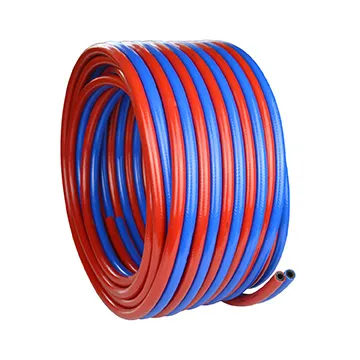Twin Welding Hose Specifications and Applications for Efficient Welding Operations
Understanding Twin Welding Hoses A Comprehensive Overview
Welding, a critical fabrication process, relies heavily on the use of various tools and equipment. Among these, twin welding hoses have become essential for many professionals in the industry. These hoses offer a streamlined solution for transporting gases needed in welding applications, significantly enhancing efficiency and safety. In this article, we will explore the features, benefits, applications, and maintenance of twin welding hoses.
What Are Twin Welding Hoses?
Twin welding hoses are comprised of two separate tubes housed within a single flexible exterior. Typically, one hose is designated for oxygen, while the other is for acetylene or other fuel gases. This design allows welders to transport both gases simultaneously, minimizing the risk of tangling and promoting easier handling, particularly in complex work environments.
Key Features of Twin Welding Hoses
1. Material and Durability Twin welding hoses are constructed from durable materials that can withstand harsh working conditions. Common materials include rubber or PVC, which provide flexibility and resistance to abrasion and chemicals.
2. Color Coding The distinct colors of the hoses—usually green for oxygen and red for acetylene—help welders quickly identify the gases they are working with, reducing the chances of mix-ups.
3. Reinforcement Many twin hoses feature reinforced linings to prevent kinking or bursting under high pressure, which is critical for maintaining a safe working environment.
4. Temperature Resistance Twin welding hoses are designed to endure high temperatures, making them suitable for various welding techniques, including MIG, TIG, and oxy-acetylene welding.
Benefits of Using Twin Welding Hoses
2. Enhanced Safety The risk of leaks and accidents is reduced with twin hoses, as they are designed to minimize the exposure of gas from individual hoses. This dual-hose system is inherently safer when used correctly.
twin welding hose

3. Reduced Setup Time By consolidating the two essential gas hoses, welders can reduce setup and teardown times, leading to increased productivity on job sites.
4. Improved Maneuverability The compact design of twin hoses allows for easier handling in tight spaces, making them ideal for both indoor and outdoor welding operations.
Applications of Twin Welding Hoses
Twin welding hoses are extensively used across various industries, including automotive, construction, manufacturing, and repair shops. Their versatility allows them to be utilized in processes ranging from metal fabrication to maintenance and repair work. For example, automotive workshops often rely on these hoses for quick repairs that require precise welding techniques.
Maintenance Tips for Twin Welding Hoses
1. Regular Inspection Welders should routinely inspect hoses for any signs of wear, cracks, or abrasions that could lead to leaks.
2. Proper Storage When not in use, hoses should be stored coiled and out of direct sunlight to prevent deterioration caused by ultraviolet rays.
3. Avoiding Kinks Always handle hoses carefully and avoid sharp bends or knots, which can weaken the structure of the hose and lead to potential failure.
4. Gas Compatibility Ensure that the hoses are regularly checked for gas compatibility, as using incorrect hoses can pose significant safety risks.
Conclusion
In summary, twin welding hoses are an essential component in many welding applications, providing efficiency, safety, and ease of use. Understanding their features, benefits, and maintenance requirements will empower welders to make informed choices that enhance their work processes. As industries continue to evolve, the importance of reliable and efficient equipment like twin welding hoses will remain a cornerstone of successful welding operations. Always remember the significance of safety and proper handling to maximize the effectiveness of these robust tools.
-
Top Quality Oxy Acetylene Hoses for Sale Fit for Welding DemandsNewsJul.28,2025
-
The Future of Pneumatic Air Tubes in IndustryNewsJul.28,2025
-
Superior and Reliable LPG Hose Pipe Solutions for Every NeedNewsJul.28,2025
-
Exceptionally Durable and Versatile Premium Braided PVC TubingNewsJul.28,2025
-
Best Adapters for Connecting Garden Hose to PVC Pipe ConnectionsNewsJul.28,2025
-
The Essential Role of LPG Hoses in Safe and Efficient Gas DistributionNewsJul.16,2025














